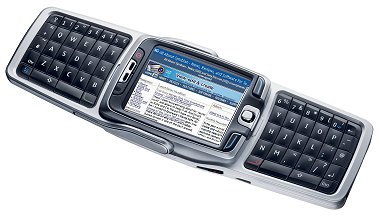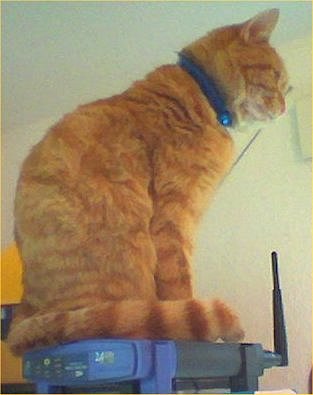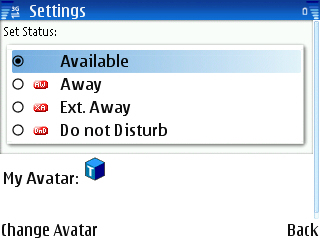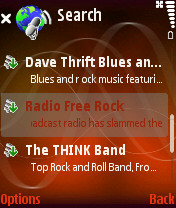One of the greatest additions to the S60 platform, in my opinion, has been Wi-Fi. Sure it’s been kicking around in the Nokia 9500 and 9300i for a good year or so, but bringing the wireless networking technology to the mass-appeal phones in S60 3rd Edition has been a masterstroke. Getting away from the mobile operator’s connections shows you just how versatile your smartphone is – and how close it is to being a real computer.
 But why is this the case? Well there are lots of potential reasons. It could be that the speed of downloading emails and web pages from the Internet is much faster that over a GPRS connection, or even a 3G data link. It could be that making a Wi-Fi connection is as simple as selecting it instead of one of the aforementioned network connections when your S60 phone asks how you want to connect.
But why is this the case? Well there are lots of potential reasons. It could be that the speed of downloading emails and web pages from the Internet is much faster that over a GPRS connection, or even a 3G data link. It could be that making a Wi-Fi connection is as simple as selecting it instead of one of the aforementioned network connections when your S60 phone asks how you want to connect.
But the main reason, in my mind, is a simple one. It means you no longer worry about how much it will cost to look at a web page. Looking at one of the most popular blogs on the Internet, Boing Boing, while they do supply an RSS feed, if you decide to call up its web page then you could be looking at over 100K for a single page. And you have no way of knowing this before you load the page – and this is the same for any site on the Internet. When you are on your mobile connection, do you take the chance to look up the football scores, in the knowledge that you won’t know until your next bill comes in just how much it will cost you? Of course, most of the Wi-Fi hotspots are run by mobile phone companies, such as T-Mobile, so you still end up paying, but with the principle of a flat rate and knowing what you will pay.
The same is true when using data applications, and it was always a concern when testing the online N-Gage Arena functions – of course every producer of those titles stressed that ‘they kept the data usage to a bare minimum’ but you still had no idea just how much of your monthly allowance Pathway To Glory was eating up. So Wi-Fi frees you up from having to worry about variable costs – you know how much the all-you-can-eat Wi-Fi timed logins in public Hot Spots will cost, and at home, with your own Wi-Fi router, or using a public 'open' connection, it’s essentially free.
Wi-Fi In Public
 Using Wi-Fi in public generally involves finding an official Hot Spot (usually rather garishly advertised – T-Mobile in the UK have bright pink logos at sit down stations where you can plug in a laptop), and when you start to browse you are taken to a log-in screen of terms and conditions and usually a request for payment details – you’ll be charged (in advance) for the amount of time you’ll use. The Hot Spot station will usually say quite prominently which SSID name you will be looking for.
Using Wi-Fi in public generally involves finding an official Hot Spot (usually rather garishly advertised – T-Mobile in the UK have bright pink logos at sit down stations where you can plug in a laptop), and when you start to browse you are taken to a log-in screen of terms and conditions and usually a request for payment details – you’ll be charged (in advance) for the amount of time you’ll use. The Hot Spot station will usually say quite prominently which SSID name you will be looking for.
If you like to live on the wild side, you'll find that many individuals in towns and cities leave their Wi-Fi networks open to the public, either accidentally or on purpose, and it's easy to connect to these using 'Easy W-LAN', though note that all guarantees go out the window here in terms of connection quality or speeds.
Thanks to Nokia’s latest browser, it is possible to get a secure connection through Wi-Fi hotspots. It can be a bit fiddly on the regular keypads of the N91 and N93, but enterprise devices (and the E61 and E70 are almost perfect in this regard) should find it no bother to confidently input all the correct details.
 Wi-Fi At Home or the Office
Wi-Fi At Home or the Office
Getting Wi-Fi at home or in the office is much easier. All you need is a Wi-Fi Router. This is a bit of technology that connects out to an Internet connection, commonly the box your cable or telephone company provides to get you high speed web access. This will act as your personal Wi-Fi hotspot, with the bonus that most routers will have a number of Ethernet ports at the rear that will let you hook in a desktop PC over cable. [And a Wi-Fi router doubles as a cat foot warmer - see right!]
Setting up your router will depend on the model: the model I use (a Linksys WRT, which is pretty popular and comes at a good price) has a web based interface for setting up all its details, including assigning the SSID name and making sure your smartphone will be able to log onto the router over Wi-Fi.
After that, it’s exactly the same as any other Wi-Fi spot, you scan for the SSID name, connect and start browsing. As easy as that.
Wi-Fi In A Real World Device
Now, Wi-Fi is not perfect. Currently each S60 application has a habit of asking you to make a new Internet connection, even if there is already an active Wi-Fi connection in place – the workround here is to use Easy W-Lan again and search for a new Wi-Fi connection, which will then pick up the existing connection.
To illustrate the difference that Wi-Fi can make, I’ve listed a few examples that can be run over a GPRS connection, but you would normally shy away from.
 Using the E61 or E70 as a great Jabber / IM client
Using the E61 or E70 as a great Jabber / IM client
The E61 and E70 are acknowledged as being great mobile messaging devices, but if you are someone who constantly moves around the home or office or don’t spend your day in front of a fixed desktop, then it can be hard to get to your IM. Using the MIDP-based Jabber client, you will be able to sign into the most popular instant messaging applications and stay logged in, with the ability to send and receive messages wherever you are at home or in the office. Using a Wi-Fi hot spot as a place where you can be “at work and available” is incredibly practical.
Using the N93 to upload to Flickr
At between 200K and 1MB per picture, to post your pictures online during a trip can start to get pricey. If you’re a shutter-bug, at the end of each day you’re probably in the habit of shifting the pictures to your desktop, and then shifting the pictures from there to your online site (be it Flickr, Zoomr, Moblog UK, or a Python hack on your web site). Why bother? Using the built in Messaging or one of the dedicated Symbian apps (e.g. Shozu) you can send the pictures directly from the handset. This saves time and effort, and thanks to Wi-Fi, you don’t need to worry about the bandwidth you’re using.
 Using the N91 as a podcatcher
Using the N91 as a podcatcher
Having a Wi-Fi connection means you are not limited to the file size transferred. My weekly rock music show (URL http://rock.thepodcastnetwork.com/ - [Hey, Ewan, you got the plug in! - Ed]) checks in at between 25MB-30MB a week – not something that a 4MB GPRS tariff could either afford or download in a reasonable amount of time. Wi-Fi doesn’t care how much data you shift and has a significantly faster transfer time. Of course, you could be transferring the MP3 file from your PC, but that defeats the purpose of the article(!) and in addition the Nokia Podcasting application will index all the shows, individual episodes and integrate with Music player, all useful.
If you have a smartphone with Wi-Fi, I hope I've convinced you to use it more. If you're about to buy a new mobile device, you now know what to look for!
Ewan Spence, September 2006
